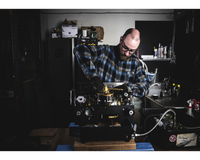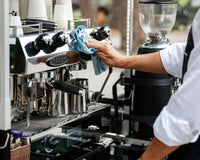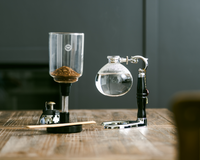WHAT’S INSIDE AN ESPRESSO MACHINE?
La Marzocco, Nuova Simonelli, Synesso, no matter which machine you are working with, there are important parts that are crucial to the machines function. Each manufacturer varies slightly, but we’ve outlined how each work.
STEAM AND WATER VALVES
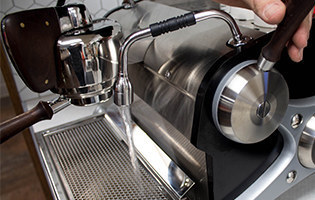
Steam and hot water valves are no less important than the group heads; they are used just as often! Most two, three and four group commercial machines only come with two steam wands and one hot water wand. The steam wands on most traditional commercial machines are placed at either end of the machine and are movable. Some older equipment steam wands will only move forward and back, but check with a dealer of the equipment - there may be a retrofit kit if this design doesn't work for you.
Hot water wands are kept very simple. They are normally an aerator threaded into a tube which draws hot water out of the boiler. In most cases, the machine must be hot for the siphoning effect of the valve to be operational. The water dispensed from the hot water wand is not suitable for beverages. It is far too hot. Additionally, using the hot water for drinks means the machine will need to cycle more often, and this will frequently lead to low steam pressure because the machine is reheating.

Both steam valves and hot water valves may be operated by a knob that one turns, a lever one activates, or a button, digital or analog, that one presses. Valves that are opened via a knob are easily repairable, and are similar to the valves we see in sink and tub faucets. Lever activated valves are just as simply constructed, but can take a little finessing to repair.
Electrically opening valves all use a solenoid to open and close the valve, but digitally operated valves can be problematic. With a digital steam or water valve, a signal must first go through the circuit board behind the button before sending the signal to the solenoid to open or close. This can be a problem to diagnose: is it the circuit that has failed, or the solenoid?
BOILER
Boilers in espresso machines vary in construction material, size and assembly. Most are brass. Some boilers are constructed out of stainless steel. The benefit of a stainless steel boiler is the fact that it will never rust, but by the time a brass boiler rusts out of a machine, it has probably been long enough for the machine to have already paid for itself from beverage production. All boilers are subject to, and victims of, lime and mineral scale build-up.

The size of a boiler can be important. With a large capacity boiler and a small wattage heating element, the machine will take longer to heat up and struggle to maintain its optimum temperature in a high volume output environment. The variables of wattage, voltage and boiler capacity are infinite and can be very confusing, but a comfortable high ratio would be about 300 watts per listed boiler liter capacity for a 220 volt machine.
The most prevalent boilers on the market use a heat exchanger to supply water to the group head(s). Heat exchangers are essentially boilers inside of a boiler. The ambient heat of the water and steam inside the main boiler heats up the cool water coming into the heat exchanger. What this means is that the temperature of the water is directly dependent on, and related to, the amount of steam pressure in the boiler. If one increases the steam pressure, they are also increasing the temperature of the water being dispensed out of the group. In two, three and four group machines, this effect takes place across the board, thus the adjustability of steam pressure and water temperature is limited.
Some commercial espresso machines come manufactured with multiple boilers; one for steam and one or more for brewing. The benefit of this is the ability to adjust either boiler to your specific needs or desires. Each boiler has a different circuit controlling its heating element, and can be dialed in for the desired temperature of brewing and steaming.
Steam boilers are filled with fresh water in two ways: with a manual-fill valve, and with an auto-fill valve. These two valves work in tandem. The main power switch for machines generally turns on the auto-fill circuit, allowing water to bypass the manual fill valve through the auto-fill solenoid and fill the boiler with water. Once the water reaches a probe (the auto-fill probe) that is threaded into the top of the boiler, this grounds the circuit out, telling the solenoid to close and the pump motor to turn off. The manual-fill valve is usually only used in emergencies when one or more of the auto-fill components has failed. These valves can also be electronically opened, but most use a standard push stem valve. Additionally, the manual-fill valve differs from the auto in that it doesn't use the pump motor to allow water in, only the static pressure of the water supply.
Keeping a close eye on the water level is very important. An empty boiler will quickly burn out the heating element.
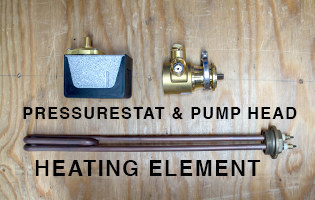
HEATING ELEMENT
Heating elements work in conjunction with a pressure switch, or pressurestat, and in some cases a high limit thermostat or a PID (proportional-integral-derivative) controller. They control the temperature, and thus also the pressure, inside the steam boiler. There are literally over a hundred different variations of elements that are used in espresso machines, but the vast majority are copper coated ceramic with a brass flange that is either threaded into or bolted on to the boiler.
PRESSURESTAT
Pressure switches are adjustable control devices that open or close electrical contacts in a cycle, as a response to changes in pressure. These have retained the name “pressurestat” here in the United States. In a machine that is cold, there is no pressure from steam pushing against the diaphragm of the pressurestat, so the circuits remain closed, allowing electricity to be supplied to the heating element. Once the machine comes up to the set pressure, the diaphragm is compressed to the desired point, the circuits open, power stops being supplied and the cycle starts over, with the pressure and temperature decreasing.
PUMP
The pump is used to push water through the group head, as well as fill the boiler. Most commercial machines use a large pump called a rotary vane pump. They are commonly made of brass and come with water in and water out fittings, a mounting flange, an adjustment screw and a drive shaft. The most common version has a clamp style mounting flange and a flat drive shaft. Other variations are a bolt on flange, using two or three bolts, a retrofitted three prong flange adaptor and or a round drive shaft. These pumps should all have an adjustment screw located on the side of the pump that one uses to increase or decrease the pressure of the water dispensing from the group head. While dispensing water, one turns the screw clockwise to increase or counterclockwise to decrease the pressure. All rotary vane pumps are required to be hooked up to a pressurized water supply. These pumps can only run without water for about 75 revolutions before the graphite bearings wear out and the pump is ruined.
Some smaller compact models (and almost all home machines) come with a different style pump, the vibratory pump. These are smaller, less expensive, and not adjustable. Some, such as the Fluid-o-tech model, are connected to the electrical wiring via a wiring boot that snaps on and is held in place with a screw. Others, such as the Ulka model, come with two spade type terminals, that may or may not be wired in with a high limit pump shut-off diode. They do not need to be installed to pressurized water, and are not attached to a pump motor, discussed next.
PUMP MOTOR

The motor turns the pump. In some machines the motor and pump are placed inside the machine, other machines have the pump is mounted outside. Some manufacturers still prefer to keep the look of their equipment the same, and so have not modified their body assembly to be able to fit a pump inside. This is inconsequential as the pumps and motors are very durable.
As with pumps, there are different models of motors available as well. The most common is the clamp flange, flat drive shaft model. Others may have a round or splined drive shaft and holes in the flange for bolts. They are available in different sizes as well, but the important thing when replacing a motor is to get the exact wattage and voltage, as well as the same microfarad rating on its start capacitor.
Espresso Machines are complex highly engineered and programmed pieces of equipment. Having a good understanding of the parts and function inside you espresso machine empowers you to care for your machine and make excellent espresso.




